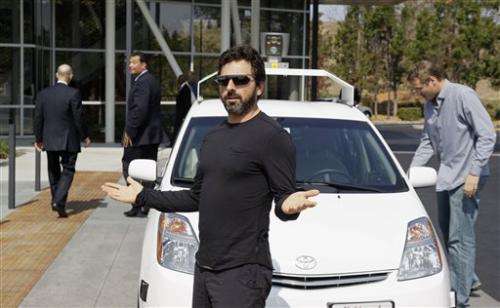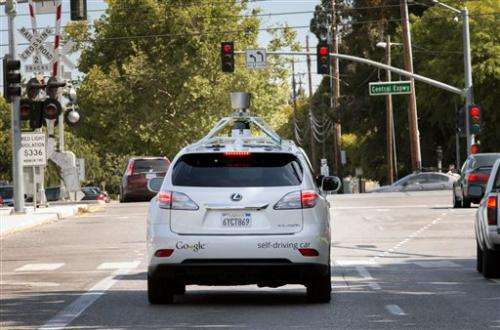Google: Driverless cars are mastering city streets (Update)

Google says that cars it is programming to drive themselves have started to master the navigation of city streets and the challenges they bring, from jaywalkers to weaving bicyclists—a critical milestone for any commercially available self-driving car technology.
Despite the progress over the past year, the cars have plenty of learning to do before 2017, when the Silicon Valley tech giant hopes to get "autonomous driving" technology to the public.
None of the traditional automakers has been so bullish. Instead, they have rolled out features incrementally, including technology that brakes and accelerates in stop-and-go traffic, or keeps cars in their lanes.
"I think the Google technology is great stuff. But I just don't see a quick pathway to the market," said David Alexander, a senior analyst with Navigant Research who specializes in autonomous vehicles.
His projection is that self-driving cars will not be commercially available until 2025.
Google Inc.'s self-driving cars already can navigate freeways comfortably, albeit with a driver ready to take control. In a new blog post, the project's leader said test cars now can handle thousands of urban situations that would have stumped them a year or two ago.
"We're growing more optimistic that we're heading toward an achievable goal—a vehicle that operates fully without human intervention," project director Chris Urmson wrote. The benefits would include fewer accidents, since in principle machines can drive more safely than people.
Urmson's post was the first official update since 2012 on a project that is part of the company's secretive Google X lab.
In initial iterations, human drivers would be expected to take control if the computer fails. The promise is that, eventually, there would be no need for a driver. Passengers could read, daydream, even sleep—or work—while the car drives.
That day is still years away, cautioned Navigant's Alexander.
He noted that Google's retrofitted Lexus RX450H SUVs have a small tower on the roof that uses lasers to map the surrounding area. Automakers want to hide that technology in a car's existing shape, he said. And even once cars are better than humans at driving, it will still take several years to get the technology from development to large-scale production.
Google has not said how it plans to market the technology. Options include collaborating with major carmakers or giving away the software, as the company did with its Android operating system.
While Google has the balance sheet to invest in making cars, that is unlikely. Certainly not in the 2017 time-frame that Google co-founder Sergey Brin has laid out.
Urmson said in an interview that 2017 is "a pretty great time frame" for people living near Google's San Francisco Bay Area headquarters to expect to have access to the technology, but in what form remains to be seen.
While Brin is his boss, and he wants to keep the boss happy, Urmson said safety will come first.
He added that he has another milestone in mind: His 10-year-old son can get behind the wheel in about five years, and knowing how teens drive, he'd like to see the technology available by 2019.
For now, Google is focused on the predictably common challenges of city driving.
To deal with cyclists, engineers have taught the software to predict likely behavior based on thousands of real-life encounters, according to Google spokeswoman Courtney Hohne. The software plots the car's path accordingly—then reacts if something unexpected happens.
Before recent breakthroughs, Google had contemplated mapping all the world's stop signs. Now the technology can read stop signs, including those held in the hands of school crossing guards, Hohne said.
While the car knows to stop, just when to start again is still a challenge, partly because the cars are programmed to drive defensively. At a four-way stop, Google's cars have been known to wait in place as other cars edge out into the intersection.
The cars still need human help with other problems. Among them, understanding the gestures that drivers give one another to signal it's OK to merge or change lanes, turning right on red, and driving in rain or fog (which requires more sophisticated sensors).
To date, Google's cars have gone about 700,000 miles (1.1 million kilometers) in self-driving mode, the company said. Hohne said more than 10,000 miles (16,000 kilometers) have been on city streets; Urmson said it would not be easy to calculate the total with greater specificity.

Five things to know about Google's self-driving cars
The director of Google's self-driving car project wrote in a blog post Monday that development of the technology has entered a new stage: trying to master driving on city streets. Many times more complex than freeways, which the cars can now reliably navigate, city streets represent a huge challenge.
Here are five things to know about the cars, and their future.
MEAN STREETS
Google says its cars have now driven about 700,000 accident-free miles on freeways in "autonomous mode"—with the car in control, though a safety driver sits behind the wheel. That's the equivalent of about 120 San Francisco-to-Manhattan-to-San Francisco road trips.
With that success, Google has been focusing on city driving for about the past year. Freeways are relatively simple for the cars—no blind corners, no cyclists and no pedestrians. City streets have all that and more, including intersections and complex interactions with other drivers, such as who goes first at a four-way stop sign.
___
TO-DO LIST
Google says that in the past year, the Lexus RX450H SUVs it has retrofitted with lasers, radar and cameras rapidly learned how to handle thousands of urban driving situations. The robot's vision can now "read" stop signs (rather than rely on a map to plot them out) and differentiate between hundreds of objects in real time. It also can negotiate construction zones much more reliably.
But the technology is far from perfect. Improvements are needed in merging and lane changes, turning right on red and handling bad weather.
___
COMING TO A NEIGHBORHOOD NEAR YOU?
Not in the near future—unless you live in Mountain View, California, where Google is located. So far, the tech giant has focused street driving in its hometown, which it has mapped parts of in tremendous detail. The mapping helps the car's computer make sense of its environment and focus on moving parts—other cars, cyclists and pedestrians.
Just four states—California, Nevada, Florida and Michigan—and the Washington capital district have formally opened public streets to testing of self-driving cars, though testing is probably legal nearly everywhere (because it is not expressly banned).
___
THE FUTURE IS (NOT QUITE) HERE
In 2012, Google co-founder Sergey Brin predicted that the public would be able to get ahold of the technology within five years. Google isn't revising that date. Initially, drivers would be expected to take control if the computer fails. Eventually, the vision goes, there would be no need for a person in the driver's seat—or at least not a driver who has to watch the road.
___
GOOGLE, THE CARMAKER?
While Google has enough money to invest in making cars, that likelihood is remote. More likely options include collaborating with major carmakers or giving away the software, as Google did with its Android operating system.
Meanwhile, traditional automakers are developing driverless cars of their own. Renault-Nissan's CEO said he hopes to deliver a model to the public by 2020.
© 2014 The Associated Press. All rights reserved.



















